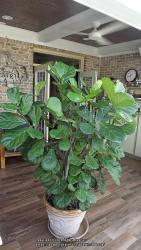Amanda, it looks like you are basically doing all the right things. I never recommend a north exposure simply because I feel that the light quality if poor, particularly for plants like this tree. That's not to say your exposure is not adequate. I just don't know. Fiddle leaf ficus are indeed trees in nature and can certainly be grown outside in full sun. But for a plant that has never been grown in full sun, it must be slowly acclimated to sun. Otherwise the leaves will surely sunburn. I wish I had some magic to share with you, but I am just a hobbyist who has grown tropical plants for 40+ years. I have over 1000 tropical plants.
The photos simply are posted here to show you what my old, mother tree looks like, outside half the year and inside half the year. I think she is healthy and I constantly have to remove branches just to keep her at 7' tall. That "inside" photo was taken after seven branches were removed. I air-layer those branches, pot them up, and then sell those divisions.

My 25+ "mother tree" while outside, April-November

My "mother tree" while inside, November-April
 My 25+ "mother tree" while outside, April-November
My 25+ "mother tree" while outside, April-November My "mother tree" while inside, November-April
My "mother tree" while inside, November-April